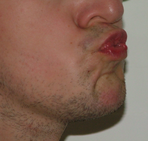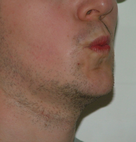Roundedness
In
Types of rounding
There are two types of vowel rounding: protrusion and compression.[3][4][5] In protruded rounding, the corners of the mouth are drawn together and the lips protrude like a tube, with their inner surface visible. In compressed rounding, the corners of the mouth are drawn together, but the lips are also drawn together horizontally ("compressed") and do not protrude, with only their outer surface visible. That is, in protruded vowels the inner surfaces of the lips form the opening (thus the alternate term endolabial), whereas in compressed vowels it is the margins of the lips which form the opening (thus exolabial). Catford (1982, p. 172) observes that back and central rounded vowels, such as German /o/ and /u/, are typically protruded, whereas front rounded vowels such as German /ø/ and /y/ are typically compressed. Back or central compressed vowels and front protruded vowels are uncommon,[6] and a contrast between the two types has been found to be phonemic in only one instance.[7]
There are no dedicated IPA diacritics to represent the distinction, but the superscript IPA letter ⟨◌ᵝ⟩ or ⟨◌ᶹ⟩ can be used for compression[8] and ⟨◌ʷ⟩ for protrusion. Compressed vowels may be pronounced either with the corners of the mouth drawn in, by some definitions rounded, or with the corners spread and, by the same definitions, unrounded. The distinction may be transcribed ⟨ʉᵝ uᵝ⟩ vs ⟨ɨᵝ ɯᵝ⟩ (or ⟨ʉᶹ uᶹ⟩ vs ⟨ɨᶹ ɯᶹ⟩).[9]
The distinction between protruded [u] and compressed [y] holds for the
Some vowels transcribed with rounded IPA letters may not be rounded at all. An example is /ɒ/, the vowel of lot, which in Received Pronunciation has very little if any rounding of the lips. The "throaty" sound of the vowel is instead accomplished with sulcalization, a furrowing of the back of the tongue also found in /ɜː/, the vowel of nurse.[13]
It is possible to mimic the acoustic effect of rounded vowels by narrowing the cheeks, so-called "cheek rounding", which is inherent in back protruded (but not front compressed) vowels. The technique is used by ventriloquists to mask the visible rounding of back vowels like [u].[14] It is not clear if it is used by languages with rounded vowels that do not use visible rounding.
| Front | Near-front | Central | Near-back | Back | |
|---|---|---|---|---|---|
| Semivowel | j ɥ ɥʷ | j̈ ɥ̈ ẅ[15] | ɰ ɰᶹ/wᵝ w | ||
| Close | i y yʷ | ɨ ÿ ʉ[16] | ɯ ɯᶹ/uᵝ u | ||
| Near-close | ɪ ʏ ʏʷ | ɪ̈ ʏ̈ ʊ̈ | ɯ̽ ɯ̽ᶹ/ʊᵝ ʊ | ||
| Close-mid | e ø øʷ | ɘ ø̈ ɵ | ɤ ɤᶹ/oᵝ o | ||
| Mid | e̞ ø̞ ø̞ʷ | ə ø̞̈ ɵ̞ | ɤ̞ ɤ̞ᶹ/o̞ᵝ o̞ | ||
| Open-mid | ɛ œ œʷ | ɜ œ̈ ɞ | ʌ ʌᶹ/ɔᵝ ɔ |
Of the open-mid vowels, [œʷ] occurs in Swedish and Norwegian. Central [œ̈] and back [ʌᶹ] have not been reported to occur in any language.
Spread and neutral
The lip position of unrounded vowels may be classified into two groups: spread and neutral. Front vowels are usually pronounced with the lips spread, and the spreading becomes more significant as the height of the vowel increases.
Roundedness and labialization
Protruded rounding is the vocalic equivalent of consonantal
In many languages, such effects are minor phonetic detail, but in others, they become significant. For example, in
]In the Northwest Caucasian languages of the Caucasus and the Sepik languages of Papua New Guinea, historically rounded vowels have become unrounded, with the rounding being taken up by the consonant. Thus, Sepik [ku] and [ko] are phonemically /kwɨ/ and /kwə/.[citation needed]
In the extinct Ubykh, [ku] and [ko] were phonemically /kʷə/ and /kʷa/.[citation needed] A few ancient Indo-European languages like Latin had labiovelar consonants.[20]
Phonemic roundedness in English
Vowel pairs differentiated by roundedness can be found in some
| Accent | Vowel | Notes | ||
|---|---|---|---|---|
| FACE | SQUARE | NURSE | ||
Cardiff[25]
|
[ei] | [eː] | [øː] | SQUARE may be open-mid [ɛː].[26] |
| General SAE[23] | [eɪ] | [eː] | [øː] | |
| Geordie[24] | [eː] | [ɛː] | [øː] | FACE may be diphthongal [ɪə ~ eɪ], whereas NURSE may be back [ |
| Port Talbot[22] | [eː] | [ɛː] | [øː] | The accent does not feature the pane–pain merger.[28]
|
In addition, contemporary Standard Southern British English as well as
| Accent | Vowel | Notes | ||
|---|---|---|---|---|
| STRUT | LOT | THOUGHT | ||
| Scottish English[29] | [ʌ] | [ɔ(ː) ~ ɒ ~ o̞] | [ɔ(ː)] | LOT often merges with THOUGHT. |
| Standard Southern British English[31] | [ʌ] | [ɔ] | [o̞ː] | |
| Western Pennsylvania English[30] | [ɑ] | [ɒ(ː)] | The LOT class also includes THOUGHT and PALM. | |
General South African English is unique among accents of English in that it can feature up to three front rounded vowels, with two of them having unrounded counterparts.[23]
| Height | Unr. vowel | Rnd. vowel | Notes | ||
|---|---|---|---|---|---|
| lexical set | realization | lexical set | realization | ||
| Close | FLEECE | [iː] | GOOSE | [yː] | GOOSE may be central [ʉː]. |
| Close-mid | SQUARE | [eː] | NURSE | [øː] | |
| Open-mid | (unpaired) | GOAT | [œː] | GOAT may be diphthongal [œɤ̈]. | |
The potential contrast between the close-mid [øː] and the open-mid [œː] is hard to perceive by outsiders, making utterances such as the total onslaught [ðə ˈtœːtl̩ ˈɒnsloːt] sound almost like the turtle onslaught [ðə ˈtøːtl̩ ˈɒnsloːt].[33]
See also
- Close back compressed vowel[ɯᵝ] = [ɯᶹ] = [uᵝ] = [uᶹ] (in Japanese and Swedish)
- Near-close back compressed vowel[ʊᵝ] = [ʊᶹ] (in Swedish)
- Close central compressed vowel[ÿ] (in Norwegian)
- Mid central compressed vowel[ø̈] (in Swedish)
- Close front compressed vowel[y] (in French, German, etc.)
- Mid front compressed vowel[ø] (in French, German, etc.)
- Close front protruded vowel[yʷ] (in Swedish)
- Near-close front protruded vowel[ʏʷ] (in Swedish)
- Close-mid front protruded vowel[øʷ] (in Swedish)
- Open-mid front protruded vowel[œʷ] (in Swedish)
- Close central protruded vowel[ʉ]
- Mid central protruded vowel[ɵ]
- Close back protruded vowel[u] (common)
- Mid back protruded vowel[o] (common)
- List of phonetics topics
Notes
- ^ Deibler (1992).
- ^ 'Further report on the 1989 Kiel Convention', Journal of the International Phonetic Association 20:2 (December 1990), p. 23.
- ^ Protrusion is also called endolabial, lip-pouting, horizontal lip-rounding, outrounding, or inner rounding (Trask 1996, p. 180).
- ^ Compression is also called exolabial, pursed, vertical lip-rounding, inrounding, or outer rounding (Trask 1996, p. 252).
- ^ Henry Sweet noted in 1890 that "the term 'inner rounding' derives from the use of the inner surfaces of the lips; the synonymous 'outrounding' derives from the forward projection of the lips. Both terms are justifiable, but their coexistence is likely to lead to serious confusion." (Trask 1996, p. 180)
- ^ Sweet (1877) noted that they are less distinctive from unrounded vowels than their counterparts.
- ɯᵝ] rather than protruded [u] (Okada 1999, p. 118); Swedish also has a back compressed [ɯᵝ] ⟨o⟩ as well as both front compressed [y] ⟨u⟩ and front protruded [yʷ] ⟨y⟩ (Engstrand 1999, p. 141); the front rounded vowels contrast in ruta 'window pane' and ryta 'roar' (Ladefoged & Maddieson 1996, p. 292).
- ^ E.g. ⟨ɨᵝ⟩ in Flemming (2002, p. 83); the IPA Handbook recommends that ⟨ᶹ⟩ "might be used" for "a secondary reduction of the lip opening accompanied by neither protrusion nor velar constriction".
- ^ Occasionally other symbols may be used, such as protruded ⟨ỿ⟩ ([yʷ]) and compressed ⟨ꝡ⟩ ([ɰᵝ]). To avoid the implication that the superscript represents an off-glide, it might be placed above the base letter: ⟨yᷱ, ɯᷩ⟩. Ladefoged & Maddieson use old IPA ⟨◌̫⟩ for protrusion (w-like labialization without velarization), while Kelly & Local (1989, p. 154) use w ⟨◌ᪿ⟩ for protrusion (e.g. ⟨øᪿ⟩) and a reversed w ⟨◌ᫀ⟩ for compression (e.g. ⟨uᫀ⟩). This recalls an old IPA convention of rounding an unrounded vowel letter like i with a subscript omega, and unrounding a rounded letter like u with a turned omega (Jespersen & Pedersen 1926: 19).
- ^ Dolphyne (1988).
- ^ Paulian (1975).
- ^ Kelly & Local (1989), p. 41.
- ^ Lass (1984), p. 124.
- ^ Sweet (1877), pp. 14, 20.
- ^ Pullum & Ladusaw (1996), p. 191.
- ^ Both [ÿ] and [ü] have been mentioned at various times in International Phonetic Association (1999), without comment on the implied difference in rounding.
- ^ Westerman & Ward (2015), p. 27.
- ^ Robins (2014), p. 90.
- ^ International Phonetic Association (1999), p. 13.
- ^ Allen (1978).
- ^ Collins & Mees (1990), pp. 88, 95.
- ^ a b Connolly (1990), pp. 122–123, 125.
- ^ a b c Lass (2002).
- ^ a b c Watt & Allen (2003), p. 269.
- ^ Collins & Mees (1990), pp. 88, 95–97.
- ^ Collins & Mees (1990), p. 95.
- ^ Wells (1982), p. 375.
- ^ Connolly (1990), pp. 122–123.
- ^ a b Wells (1982), pp. 399–403.
- ^ a b Labov, Ash & Boberg (2006), pp. 88–9.
- ^ a b Cruttenden (2014), pp. 122, 126–128, 130.
- ^ Lass (2002), pp. 116, 118–119.
- ^ Lass (2002), p. 118.
References
- Allen, W. Sidney (1978). Vox Latina: A Guide to the Pronunciation of Classical Latin (2nd ed.). Cambridge University Press. ISBN 0-521-37936-9.
- ISBN 0-25320294-9.
- Collins, Beverley; Mees, Inger M. (1990). "The Phonetics of Cardiff English". In Coupland, Nikolas; Thomas, Alan Richard (eds.). English in Wales: Diversity, Conflict, and Change. Multilingual Matters Ltd. pp. 87–103. ISBN 1-85359-032-0.
- Connolly, John H. (1990). "Port Talbot English". In Coupland, Nikolas; Thomas, Alan Richard (eds.). English in Wales: Diversity, Conflict, and Change. Multilingual Matters Ltd. pp. 121–129. ISBN 1-85359-032-0.
- Cruttenden, Alan (2014). Gimson's Pronunciation of English (8th ed.). Routledge. ISBN 9781444183092.
- Deibler, Ellis (1992). "Alekano Organised Phonology Data".
- ISBN 9964-3-0159-6.
- Engstrand, Olle (1999). "Swedish". Handbook of the International Phonetic Association: A Guide to the Use of the International Phonetic Alphabet. Cambridge University Press. pp. 140–142. ISBN 0-52163751-1.
- Flemming, Edward S. (2002). Auditory Representations in Phonology. Routledge. ISBN 0-81534041-9.
- ISBN 0-52163751-1.
- Kelly, John; Local, John (1989). Doing Phonology: Observing, Recording, Interpreting. Manchester University Press. ISBN 0-7190-2894-9.
- ISBN 978-3-11-016746-7.
- ISBN 0-631-19815-6.
- Lass, Roger (1984). Phonology: An Introduction to Basic Concepts. Cambridge University Press. ISBN 0-521-28183-0.
- Lass, Roger (2002). "South African English". In Mesthrie, Rajend (ed.). Language in South Africa. Cambridge University Press. ISBN 9780521791052.
- Okada, Hideo (1999). "Japanese". Handbook of the International Phonetic Association: A Guide to the Use of the International Phonetic Alphabet. Cambridge University Press. pp. 117–119. ISBN 0-52163751-1.
- Paulian, Christiane (1975). "Le Kukuya, langue teke du Congo: phonologie – classes nominales". Bibliothèque de la SELAF. 49–50.
- ISBN 0-226-68536-5.
- Robins, R. H. (2014). General Linguistics (4th ed.). Routledge. ISBN 978-0-582-29144-7.
- Sweet, Henry (1877). A Handbook of Phonetics. Clarendon Press.
- Trask, R. L. (1996). A Dictionary of Phonetics and Phonology. Routledge. ISBN 0-415-11260-5.
- Watt, Dominic; Allen, William (2003). "Tyneside English". Journal of the International Phonetic Association. 33 (2): 267–271. S2CID 195784010.
- ISBN 0-52128540-2.
- Westerman, D.; Ward, Ida C. (2015) [1933]. Practical Phonetics for Students of African Languages. Routledge. ISBN 978-1-138-92604-2.
External links
 The dictionary definition of endolabial at Wiktionary
The dictionary definition of endolabial at Wiktionary The dictionary definition of exolabial at Wiktionary
The dictionary definition of exolabial at Wiktionary The dictionary definition of unrounded at Wiktionary
The dictionary definition of unrounded at Wiktionary




